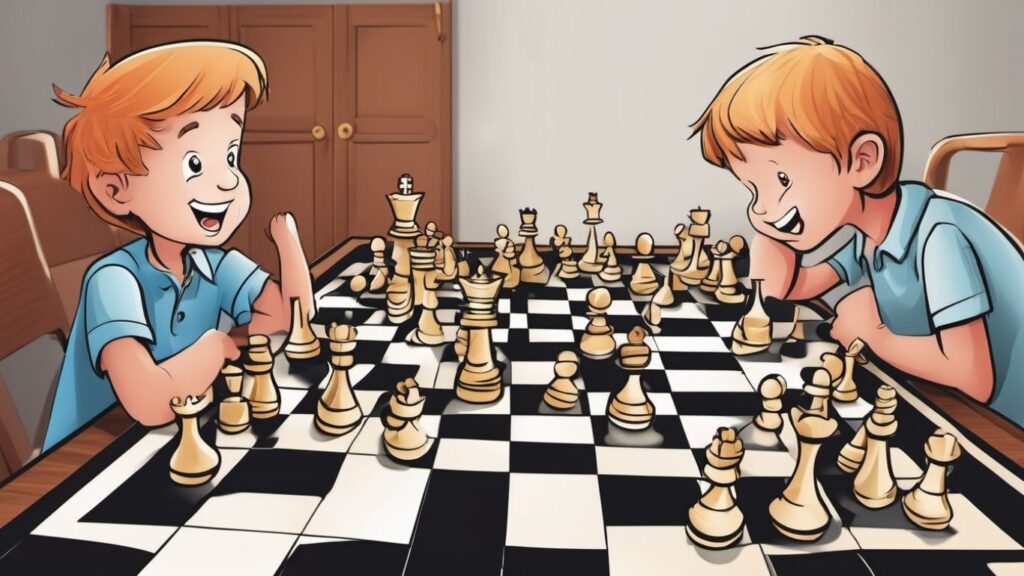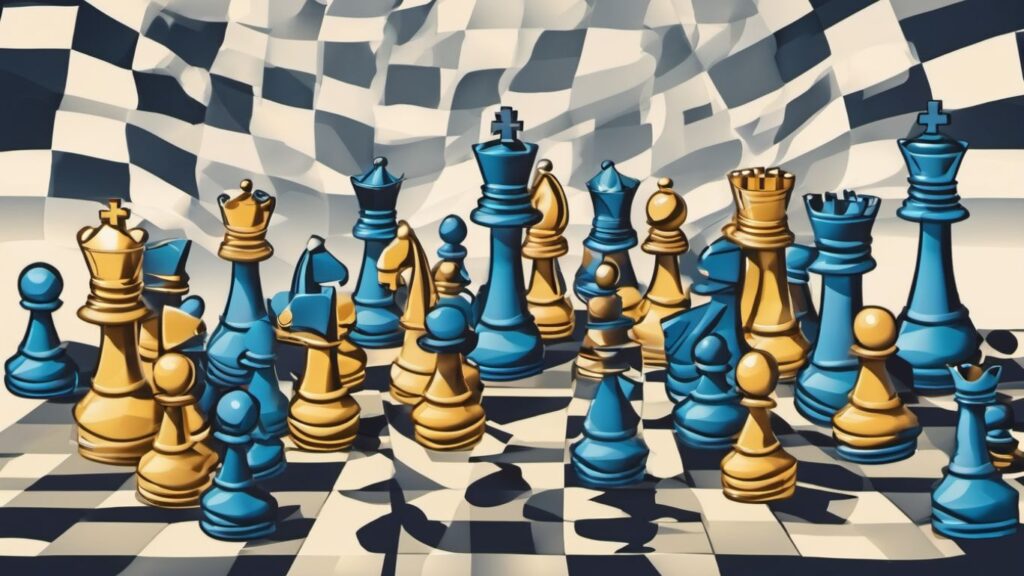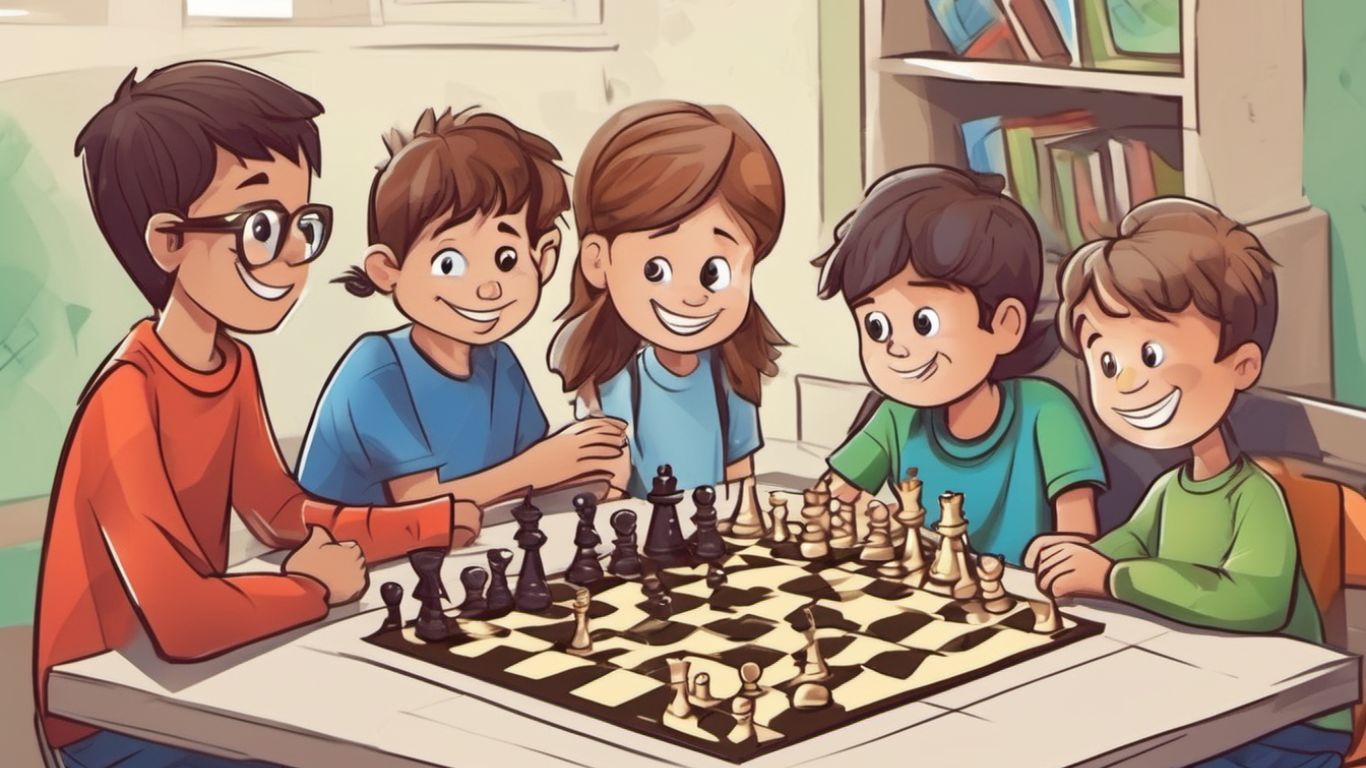First, let’s get to know our chessboard and pieces!
- Chessboard: Think of the chessboard as our playground. It has 64 squares, and they alternate between light and dark colours.
- Pieces: Each player has 16 pieces. We’re going to call them our team members. We have:
- Little Soldiers (Pawns): They are our runners and can move one step forward.
- Castles (Rooks): They can move forward, backwards, or sideways in a straight line.
- Horses (Knights): They can jump in an “L” shape.
- Diagonal Friends (Bishops): They move diagonally across the board.
- Super Piece (Queen): She can move in any direction, as far as she likes.
- Coach (King): He can move one square in any direction, but it is essential and must be kept safe.
The Movements of Each Chess Piece
Let’s learn how each piece moves:

- Little Soldiers (Pawns): They move one square forward. For their first move, they can choose to move two squares!
- Castles (Rooks): They move in straight lines, like fast cars zooming across the board.
- Horses (Knights): They move in an “L” shape: two squares in one direction and then one square perpendicular.
- Diagonal Friends (Bishops): They move diagonally, like good climbers scaling a diagonal path.
- Super Piece (Queen): She’s our best piece and can move like rooks and bishops.
- Coach (King): He moves one square in any direction. Our goal is to keep him safe.
The Importance of Protecting the King
Our Coach (King) is essential. We need to keep him safe at all times. If the other team gets too close to capturing our Coach, we say, “Your king is in trouble” (Check). And if he can’t move anywhere safely, we say, “The king can’t escape, you win!” (Checkmate).
Basic Strategies
Controlling the Center
The middle of the board is like the best part of the playground. If we control it, our pieces can move around more easily and do more things. So, always try to move your pieces to the centre.
Developing Pieces
Just like in a race, we need our team ready to play. Move your little soldiers (pawns) first to open paths for your castles, horses, and diagonal friends.
Capturing Opponent’s Pieces
Capturing (or tagging) the other team’s pieces helps you win. If your piece can land on a square where an opponent’s piece is, you can capture it and remove it from the board.
The Value of Planning Ahead
Making intelligent moves means thinking about what your opponent might do next. Always ask yourself, “If I move here, what will happen?”
Interactive Exercises
Let’s play some games to practice!
Spot the Movement
I’ll show you a piece’s starting position. Can you show me all the places where it can be moved?
Build Your Army
Set up the pieces on the board. Let’s see where each piece goes and why it’s essential.
Capture Challenge
Here’s a scenario: Can you use one of your pieces to capture an opponent’s piece by moving correctly?
Checkmate Puzzles
Let’s solve a puzzle where you must make the king unable to escape. Remember, this means we win!
King’s Escape
Your king is in trouble! Can you move him to a safe spot?
Strategy Race
Let’s see who can control the centre of the board first. Ready, set, go!
FAQs
Q: How do I know which pieces to move first?
A: It’s usually a good idea to start by moving your little soldiers (pawns) to open up paths for your other pieces. Try to control the centre of the board early on.

Q: What happens if a pawn reaches the other side of the board?
A: When a pawn reaches the opposite side, it gets promoted! You can turn it into any other piece, like a queen, rook, bishop, or knight. Most players make it a queen because she’s the most powerful piece.
Q: Can a knight jump over other pieces?
A: Knights are unique because they can jump over other pieces on the board. That makes them very useful for surprising your opponent!
Q: What does “castling” mean?
A: Castling is a special move involving your king and one of your rooks. It helps protect your king and get your rook into action. To castle, move your king two squares towards the rook, then move the rook to the square next to the king. Remember, there are some rules: neither piece should have moved before, no pieces should be between them, and the squares the king moves through shouldn’t be under attack.
Q: What is “en passant”?
A: “En passant” is a particular pawn capture. If your opponent moves a pawn two squares forward from its starting position, you can capture it as if it only moved one square. This must be done immediately after the two-square move.
Q: What should I do if I keep losing my queen early in the game?
A: If you lose your queen early, you might place her on dangerous squares. Try bringing her out later in the game and protecting her from other pieces.
Q: Can the king capture pieces?
A: The king can capture pieces, but he can only move one square at a time. Always make sure he stays safe!
Q: How can I tell when my opponent is trying to set a trap?
A: If your opponent makes an unexpected move, take a moment to think about their plans. Ask yourself, “Why did they move there?” and “What are they trying to do?” This can help you spot traps and avoid them.
Q: What if we both only have kings left; can anyone win?
A: No, if both players only have their kings left, the game is a draw because neither king can checkmate the other.
Q: Is it okay to take back a move if I made a mistake?
A: In friendly games, taking back a move is usually okay if everyone agrees. But in official matches, you can’t take it back once you move a piece.
We hope these FAQs help you enjoy and understand chess better. Remember, practice makes perfect, and the more you play, the more you’ll improve!
Conclusion
Chess is like a fun playground where all our pieces have special abilities. By learning how they move and making smart moves, we can have lots of fun while playing and even win games. Always protect your Coach (King), think ahead, and enjoy the game!
Let’s get started and have some fun with chess!










